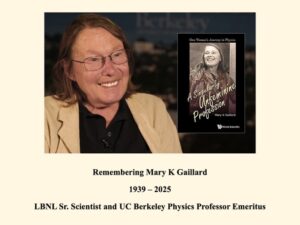Mary K Gaillard passed away on Friday, May 23. She was an LBL Senior Scientist and UC Berkeley Physics Professor from 1981 until she retired, serving as the LBL-UCB Theory Group Leader for three years in the 80’s.
 Mary K graduated in 1960 from Hollins College, a small college in Virginia, where her physics professor recognized her talent, helping her get jobs at the Ringuet laboratory in France and at the Brookhaven National Lab. In 1961 she got a masters degree at Columbia University and in 1968 a Doctorate in Theoretical Physics from the University of Paris at Orsay. Before coming to Berkeley she was a research scientist with the French CNRS and, for many years, a visiting scientist at CERN.
Mary K graduated in 1960 from Hollins College, a small college in Virginia, where her physics professor recognized her talent, helping her get jobs at the Ringuet laboratory in France and at the Brookhaven National Lab. In 1961 she got a masters degree at Columbia University and in 1968 a Doctorate in Theoretical Physics from the University of Paris at Orsay. Before coming to Berkeley she was a research scientist with the French CNRS and, for many years, a visiting scientist at CERN.
Mary K was a theoretical physicist of great power, gifted with both deep physical intuition and a very high level of technical mastery. She used her gifts to great effect and made many important contributions to the development of the Standard Model of elementary particle physics, that was established precisely during the course of her career. She pursued her love of physics with powerful determination, in the face of overt discrimination that went well beyond what may still exist today. She fought these battles and produced beautiful, important physics while raising three children as a devoted mother.
After obtaining her master’s degree at Columbia, Mary K accompanied her first husband, Jean-Marc Gaillard, to Paris, where she was rebuffed in many attempts to obtain a position in an experimental group. She next tried and failed, multiple times, to find an advisor in theoretical physics, which she actually preferred to experimental physics but had not pursued because it was regarded as an even more unlikely career for a woman. Eventually, and fortunately for the development of elementary particle physics, Bernard d’Espagnat agreed to supervise her doctoral research at the University of Paris. While she quickly succeeded in producing significant results in her research, respect and recognition were still slow to come. She suffered many slights from a culture that could not understand or countenance the possibility of a woman theoretical physicist and put many obstacles in her way. Respect and recognition did finally come in appropriate measure, however, by virtue of the undeniable impact of her work.
Her contributions to the field are numerous, here are just a few highlights. During an intensely productive period in the mid 70’s she completed a series of projects that established the framework for the decades to follow that would culminate in the Standard Model. Famously, using the known properties of the “strange” K mesons, she successfully predicted the mass scale of the fourth “charm” quark prior to its discovery. In the framework of Grand Unified Theories she also predicted the mass of the fifth “bottom” quark, a successful though still speculative prediction. Other impactful work, extracting the experimental consequences of theoretical constructs, laid down the paths that were followed to experimentally validate the charm quark discovery and to search for the Higgs boson required to complete the Standard Model. Another key contribution showed how “jets,” streams of particles created in high energy accelerators, could be identified as manifestations of the “gluon” carriers of the strong force of the Standard Model.
In the 80’s, when the Superconducting Super Collider and the Large Hadron Collider were under discussion, she showed that they could successfully uncover the mechanism of ”electroweak symmetry breaking” required to understand the Standard Model weak force, even if it was “dynamical”, an experimentally much more challenging possibility than breaking by a Higgs boson. For the remainder of her career she focused principally on work to address issues that are still unresolved by the Standard Model. Much of this research involved “supersymmetry” and its extension to encompass the gravitational force, theoretical constructs that originated in work of her second husband, the late Bruno Zumino, also a LBL-UCB Theory Group member.
Mary K’s accomplishments were recognized by numerous honorary societies and awards, including the National Academy of Sciences, the American Academy of Arts And Sciences, and the J. J. Sakurai Prize for Theoretical Particle Physics of the American Physical Society. She served on numerous governmental and academic advisory panels, including six years on the National Science Board.
She tells her own story in a memoir, A Singularly Unfeminine Profession, published in 2015. She will surely be remembered when the final history of elementary particle physics is written.
– Written by Michael Chanowitz